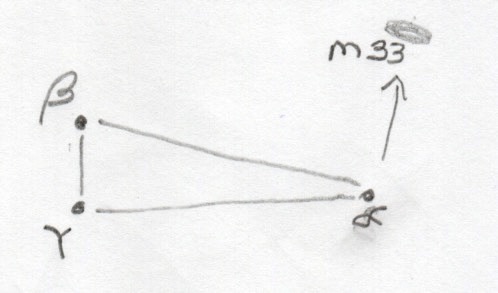Constellations: Capricornus, Cygnus, Lyra, Perseus, Triangulum
Clusters: NGC 869/884, α Persii Cluster
Stars: 16 Cygni, Algol, Mirfak
Planet: Neptune
Messier Objects: M13 (Hercules Cluster), M33 (Pinwheel Galaxy), M45 (Pleiades)
Located, Not Observed: Aquila, Cassiopeia, Scorpius, Summer Triangle, Taurus, Teapot, Ursa Major, Ursa Minor
Location: Sky Circle, Kejimkujik National Park
Date: 2017-09-24/25
Time: 8:00 PM - 12:30 AM ADT
Instrument: Visual + Binoculars (10x30 IS) + Kejimkujik's telescope
Transparency: Good (3)
Seeing: Good (3)
Temperature: 16º C - 14º C
Clear skies, no clouds. Little if any breeze. Some humidity but good seeing and transparency.
Lyra
Time: 8:37 PM ADT
S&T Chart Reference: 63
Instrument: Visual + Binoculars (10x30 IS)
Identified Vega visually then used binoculars to view ε1, ε2, δ1 and δ2. Sheliak (β), ζ and γ were found naked eye.
NGC 869/884
Time: 8:48 PM ADT
S&T Chart Reference: 1, 2, 13
Instrument: Binoculars (10x30 IS)
I drew an imaginary line between Navi and Ruchbah in Cassiopeia then continued along that line a little over once that distance to find this double cluster. Both appeared as grey fuzzies with a few bright stars in their centres.
 |
Cygnus Time: 10:30 PM - 10:38 PM ADT S&T Chart Reference: 62, 73, H Instrument: Kejimkujik's telescope I tried to locate 16 Cygni with binoculars but was unsuccessful. Chris Young used the Park's telescope to locate this double star and we discovered two in the same FOV - 16 Cygni and θ Cygni. The latter pair were located at 6:30 o'clock to 16 Cygni and were much fainter. |
|
|
Triangulum M33 / Pinwheel Galaxy |
M13 (Hercules Cluster)
Time: 10:50 PM ADT
S&T Chart Reference: 52, 54
Instrument: Visual + Binoculars (10x30 IS)
Gillian Webster requested assistance to find M13. I first showed her on a star chart where the Keystone was located relative tot he head of Draco which she knew. Using binoculars, we located M13.
Capricornus
Time: 10:55 PM ADT
S&T Chart Reference: 66, 68, 77
Instrument: Visual + Binoculars (10x30 IS)
Gillian asked for assistance in locating "Orion's Underpants", aka Capricornus. She easily saw it after I described it as a clown smile. I pointed out Algeidi (α), Dabih (β) and noted they were both double stars. Using binoculars, we were both able to see the double stars in each.
| Neptune Time: 11:05 PM ADT Instrument: Binoculars (10x30 IS) Saw Fomalhaut in Pisces Austrinus and heard someone saw Neptune was in Aquarius (just above where I was looking). Looked for the planet and found it near Hydor. Bright blue, very clear limb borders compared to the neighbouring stars. |
 |
M45 (Pleiades)
Time: 11:10 PM ADT
S&T Chart Reference: 14, 15, A
Instrument: Visual + Binoculars (10x30 IS)
As Taurus rose higher in the sky, M45 became visible as well. Always a joy to see this bright jewel, initially naked eye and then have the star field fill my binocular FOV. Glorious!
Perseus + α Persii Cluster
Time: 11:20 PM ADT
S&T Chart Reference: 2, 13
Instrument: Visual + Binoculars (10x30 IS)
Perseus rose high above the tree line and was very easily seen naked eye. All stars, including those in his 'arms' had previously eluded me but were now easily seen. Amazing to see! Using my binoculars, I looked more closely at Mirfak and its surrounding α Persii Cluster and at Algol. I had hoped to begin to track Algol's variability, especially now that it was at a minimum.
